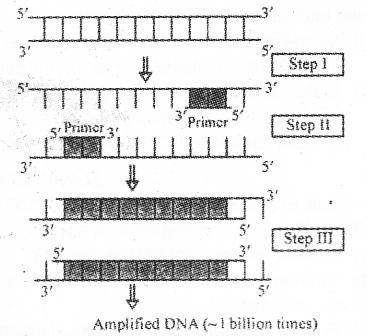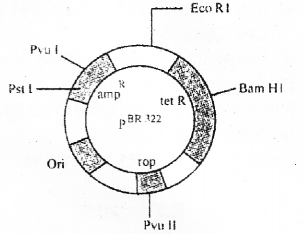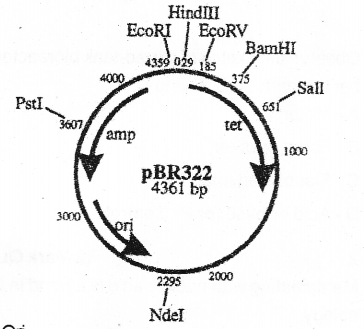Kerala Plus Two Botany Chapter Wise Previous Questions Chapter 4 Biotechnology: Principles and Processes
Question 1.
Rinku with a circular DNA contains sequence (MARCH-2010)
5′-> GGAATTCC -> 3′
3′ -> CCTTAAGG -> 5′
She wishes to add a new segment of DNA into it.
a) Identify the technology she planned.
b) Suggest the specific enzyme to make a cut in the DNA with above sequence.
c) Name the category of enzyme you suggested.
d) How this enzyme identifies the sequence ?
e) Draw the cut ends of the DNA with sequence.
OR
Rashid isolated a natural plasmid from a bacterium and planning to facilitate cloning.
a) What are the minimum requirements for considering the isolate & plasmid as a vector ?
b) How he identifies whether a foreign DNA is inserted or not after cloning ?
Answer:
a) Recombinant DNA technology
b) Eco- R-1
c) Restriction endonuclease
d) Palindromic sequence
e)

OR
a) It should have origin of replication (ori), selectable marker for identifiying transformants, cloning sites.
b) Selectable marker which helps in identifying and eliminating non transforms and selectively permitting the growth of transformants. The markers commonly unsed are the gene encoding reistance to antibiotics such as tetracycline, ampicillin etc.
Question 2.
Diagram shows a typical agarose gel showing migration fragments. (MAY-2010)

a) Which of the bands has largest and smallest DNA fragments?
b) How can you make fragments of DNA for electrophoresis ?
c) Explain separation of DNA fragments using electrophoresis.
d) Point out a method to visualize the separated DNA fragments after electrophoresis.
Answer:
a) a is the largest DNA fragment and d is the smallest DNA fragment
b) DNA fragments can be made by cutting the DNA by restriction endonuclease.
c) Separation of DNA fragments takes place through gel electrophoresis where the cut DNA fragments
matrix. The separation takes place according to the size of the DNA.
d) The DNA separated by electrophoresis is visualized by staining it with Ethidium Bromide dye and viewing it under UV light. The fragments of DNA appears as orange coloured bands.
Question 3.
The picture given below shows the technique used forgenerating multiple copies of the gene of interest. (MARCH-2011)

a) What is the technique called?
b) Name the reactions at Step I, Step II, Step III.
c) Explain the principle underlying this technique of DNA amplification.

The above picture shows cloning vector pBR 322.
a) What is Ori? Give its importance.
b) How does the insertion of foreign DNA at Bam Hi site selected ? What is ampR?
c) How many cloning sites are depicted in this vector as shown in the figure?
Answer:
a) Polymerase chain reaction
b) Step I denaturation
Step II annealing
Stepl II extention/amplification
c) Multiple copies of gene of interest is synthesized invitro by using the set of primer,/Taq polymerase and deoxy nucleotides
OR
a) Origin of replication. Controlling the copy no.of linked DNA
b) Due to insertion of Foreign DNA at Bam H1 site, recombinant plasmid will lose tetracycline resistance, thus recombinants will not grow in the medium containing tetracycline
c) 5 cloning sites-Eco R1, Bam H1, PuvII, Pst1, Pvu1
Question 4.
In a class room seminar on cloning vectors, your friend asked to explain the steps to introduce the plasmid DNA to a bacteria cell, Micro injection and biolistics. Answer his questions. (MAY-2011)
Answer:
For this, bacterial cells must first be made ‘competent’ to take up DNA. This is done by treating them with a specific concentration of a divalent cation, such as calcium, Recombinant DNA can then be forced into such cells by incubating the cells with recombinant DNA on ice, followed by placing them briefly at 420C (heat shock), and then putting them back on ice. This helps to introduce the plasmid DNA into bacterial cell.
Micro injection – In this recombinant DNA is directly injected into the nucleus of an animal cell.
Biolistics – In this cells are bombarded with high velocity micro-particles of gold or tungsten coated with DNA.
Question 5.
Observe the relation in the first pair and fill up the blank in the second. (MAY-2011)
Cry I Ac: Control cotton bollworm
……………: Control corn borer
Answer:
Cry I Ab ………. control corn borer.
Question 6.
Restriction endonucleases are the enzymes used to cut the DNA molecules. (MARCH-2012)
a) Give the general term of the specific sequences where these enzymes cut the DNA.
b) Name the enzyme that joints the foreign DNA and vector DNA.
c) Give any two procedures to introduce the recombinant DNA into the host cell.
OR
During genetic engineering Vector with foreign DNA is transferred into a host bacterium. The next target will be the selection of transformants from non- ‘ transformants.
How antibiotic resistance and insertional inactivation is exploited for this purpose?
Answer:
a) Palindromic sequence or recognition sequence
b) DNAIigase
c) Direct gene transfer by gene gun (biolistics) Direct gene transfer by micro injection
OR
Antibiotic gene is used us selectable marker to identify the recombinants from non recombinant. Insertional inactivation is used to identify the transformants as white coloursed and non transformants as blue coloured
Question 7.
While studying nucleotide sequence. Raj found the following sequence which can be recognized by some enzymes : (MAY-2012)
5′- GAATTC – 3′
3′- CTTAAG – 5′
a) Give salient features of this sequence.
b) Write name of enzymes which recognize such sequences.
c) Elaborate importance of this enzyme in Genetic engineering.
OR
A group of students came to know about recombinant DNA technology. They want to know how scientists can produce a new desired product using rDNAtechnology. Can you give them an idea about the important steps that are involved in this process?
Answer:
a) Palindromic sequence
b) Restriction endonuclease enzyme
c) The enzyme cut at specific nucleotide sequence and get sticky ends.The same restriction enzyme is used to cut both foreign DNA and cloning vector.
OR
Recombinant DNA technology involves several steps.
They are
1) Isolation of the Genetic Material (DNA)
2) Cutting of DNA at Specific Locations
3) Amplification of Gene of Interest using PCR
4) Insertion of Recombinant DNA into the Host Cell Organism
5) Obtaining the Foreign Gene Product
6) Down stream processing
Question 8.
Jaya read in a Biotechnology book that alien DNA can be introduced into host ceil by micro injection and biolistics. Explain these methods. (MARCH-2013)
Answer:
1) Micro-injection- The recombinant DNA is directly injected into the nucleus of an animal cell.
2) Biolistics or gene gun- The cells are bombarded with high velocity micro-particles of gold or tungsten coated with DNA. It is suitable for plants.
Question 9.
Genetic Engineering include creation of recombinant DNA with the help of restriction enzymes. (MARCH-2013)
a) Explain recombinant DNA technology.
b) What are restriction enzymes? Name a restriction enzyme.
Answer:
a) Recombinant DNA technology involves several steps.
They are
1) Isolation of the Genetic Material (DNA)
2) Cutting of DNA at Specific Locations
3) Amplification of Gene of Interest using PCR
4) Insertion of Recombinant DNA into the Host Cell /Organism
5) Obtaining the Foreign Gene Product
6) Downstream Processing
b) Restriction enzyme is used to cut DNA at specific nucleotide sequence Examples are EcoR1 ,Hind111 etc.
Question 10.
Gel electrophoresis is a technique to separate fragments of DNA from a mixture. Some of the events of electrophoresis are given below. Arrange the events in order: (MAY-2013)
1) Cutout DNA bands
2) Expose to UV
3) Force DNA to move through gel
4) Stain DNA with ethidium bromide.
Answer:
Force DNA to move through the gel, stain DNA with ethidium bromide expose to UV ,cut out DNA bands.
Question 11.
Identify palindrome sequence from the following. (MAY-2013)
1) 5′-GAATTC-3′
3′-CTTAAG-5′
2) 5′-ATCG-3′
3′-TACG-5′
3) 5′ – AAAAA – 5′
5′ – TTTTT – 3′
4) 5′-CCCCC-3′
3′-GGGGG-5′
Answer:
5′ ___GAATTC ____ 3′
3′ ____ CTTAAG ____ 5′
Question 12.
_________ are the enzymes used for cutting the DNA molecule into fragments. An example for this type of enzyme is Eco Ri. What does Eco, R and I stand for? (MARCH-2014)
Answer:
UB Restriction Endonuclease,
Eco- Escherichia coli, R- letter ‘R’ is derived from the name of strain, I— It indicate the order in which the enzymes were isolated from that strain of bacteria.
Question 13.
Use of a thermostable DNA polymerase from the bacterium, Thermus aquaticus made it possible to generate billion copies of DNA in a very short time using a process. (MARCH-2014)
a) Name the process.
b) Name the three important steps involved in this process.
Answer:
a) Polymerase chain reaction
b) Denaturation, Anealing, Extension
Question 14.
There are many features required to facilitate successful cloning in to a vector. Write shortly any two such features required by a vector. (MAY-2014)
Answer:
Origin of replication (ori): This is a sequence from where replication starts and any piece of DNA when linked to this sequence can be made to replicate within the host cells.
Selectable market: Genes encoding resistance to antibiotics are considered as useful selectable markers which helps in identifying and eliminating non transformants and selectively permitting the growth of the transformants.
Question 15.
Recombinant DNA technology can be accomplished only if we have the following key tools, ie. Restriction enzymes, Polymerase enzyme, Ligases and Vectors. (MARCH-2015)
State the functions of
a) Ligases
b) Restriction Enzymes
Answer:
a) Ligase- Enzyme which is used to join the DNA fragments
b) Restriction Enzymes- It is used to cut DNA at specific locations
Question 16.
Figure representing the reactions associated with Polymer Chain Reaction (PCR). Name the steps A, B, C in the process (MARCH-2015)

Answer:
A — Denaturation
B — Annealing
C — Extension/Elongation
Question 17.
Observe the cloning vector and explain the following: (MAY-2015)

a) Ori
b) Bam HI
Answer:
a) ori-origin of replication
b) Bam HI- restriction enzyme
Question 18.
A multinational company successfully cloned a gene of interest and also optimized the conditions to induce the expression of target protein. (MAY-2015)
a) Name the apparatus for large scale production of such proteins.
b) Briefly explain the apparatus.
Answer:
a) Bioreactor
b) It is the large culture vessel (100-1000 litres) used for the production of large quantities of recombinant protein, enzymes, etc. it,provides optimum growth conditions (temperature, pH, substrate, salts, vitamins and oxygen). It consist of agitator system, an oxygen delivery system and a foam control system, a temperature control system, pH control system and sampling ports.
Question 19.
Observe the sketch of stirred-tank bioreactor and label the parts A, B. C and D. (MARCH-2016)

Answer:
A – motor
B – Foam breaker
C- Flat bladed impeller
D – Acid or base for PH Control
Question 20.
Manipulating with nucleic acid is a trend in Biotechnology. (MARCH-2016)
a) Name any one organism used as vector.
b) What are DNA polymerase?
Answer:
a) Ecoli
b) It helps to add nucleotide one by one on template srtand (polymerization of deoxy ribonucleotides)
Question 21.
Electrophoresis is a method commonly used in Biotechnology. Write briefly about GelElectrophoresis. (MAY-2016)
Answer:
In this method DNA fragments are separated accord-ing to their charge and size.
DNA is negatively charged molecules they move through agarose gel towards positively charged anode, DNA fragments are stained by Ethidium bromide, separated fragments can be observed as orange coloured bands under UV light.
Question 22.
Genetic engineering is a promising branch recently developed in biological science. (MAY-2016)
a) Expand PCR and name three steps in each cycle.
b) What is a plasmid? Name three features required for cloning vectors.
Answer:
a)PCR or polymerase chain reaction involves 4 steps
1) Denaturation – It involves the separating of DNA strands.
2) Annealing – The double strands are synthesised from free nucleotides by the action of DNA polymerase.
3) Extension – The length of the strands are increased as a result of addition of more and more nucleotides. The process of replication is repeated many times & billions of copies of DNA is synthesised.
OR
b)Plasmids are circular double stranded DNA molecules occurring in extra chromosomal state
1) Ori (Origin of replication) it is the sequence from where replication starts.
2) Cloning sites: For linking the alien DNA into the vector, there must be preferably single recognition sites because more than one recognition sites within the vector results several fragments.
3) Selectable markers are employed in rDNA technology for selecting the recombinants from non recombinants.
Question 23.
The following photograph shows the result of a technique showing the separation of DNA. (MARCH-2017)

a) Name the technique.
b) How the separated DNA is visualized?
c) DNA fragments of size 500bp and 2000 bp are separated by this process. Which fragment will migrate fast. Why?
OR
B) Different methods have been suggested to introduce alien DNA into host cells. Given and explain any three methods adopted for this purpose.
Answer:
A) a) Gel electrophoresis
b) The separated fragments of DNA can be visualized only after staining with ethidium bromide followed by exposure to uv radiation. DNA will be visualized as bright orange coloured bands on the gel.
c) 500 bp migrate fast because it is the smaller fragment found nearer to anode than other fragments on the gel.
OR
B) 1) Micro-injection-recombinant DNA is directly injected into the nucleus of an animal cell.
2) Biolistics or gene gun – cells are bombarded with high velocity micro-particles of gold or tungsten coated with DNA. It is suitable for plants.
3) Disarmed pathogen – vectors when allowed to infect the cell, transfer the recombinant DNA into the host.
Question 24.
Sequences of base pairs in DNA that reads the same on both the strands when the orientation of reading is kept the same are called ______ sequences. (MARCH-2017)
Answer:
Palindromic nucleotides
Question 25.
Origin of replication and selectable markers are the two important features required for a cloning vector. Explain their role in facilitating cloning. (MAY-2017)
Answer:
Up Origin of replication – It is the start of replication required for making many copies of desired gene. Selectable markers – They are antibiotic resistant gene that helpful in identifying recombinants from non recombinants.
Question 26.
Rhizome, bulbil, offset and bulb are different methods of vegetative reproduction in plants. Of these, the vegetative reproductive structures of Agave and Ginger are and respectively. (MAY-2017)
Answer:
Bulbil, Rhizome
Question 27.
Denaturation, Annealing and Extension are three steps of a process used for gene amplification: (MAY-2017)
a) Name the process.
b) Name the organism from which the DNA polymerase for this process is extracted.
Answer:
a) Polymerase Chain Reaction (PCR)
b) Thermusaquaticus
